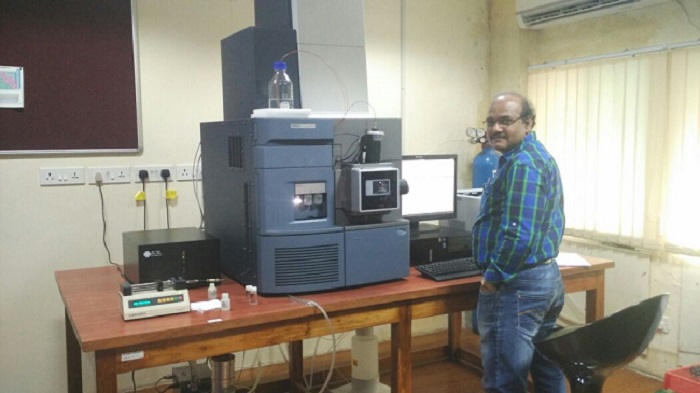- APPLY FOR SLOT
- Internal Users
- External Users
- SLOT BOOKING STATUS
High Resolution - Mass Spectrometry Laboratory (HRMS)

Phone : +91-3222-283342
Location : OB / FF / 9 & 10, CRF
Facilitator :
Prof. Samik Nanda, Chemistry
Email: snanda@chem.iitkgp.ac.in, Contact:+91-3222-283328
For Internal Users - Click Here to apply for Slot
For External Users - Click Here to apply for Slot
Objectives
The Xevo G2 QTof mass spectrometry system, being a combined quadrupole and time-of-flight mass spectrometer, is intended for use as a research tool. Its detector acquires thousands of complete spectra per second. These spectra are mass-corrected and summed for a defined scan time. Equipped with a ZSpray atmospheric pressure ionization (API) source along with a built in lock-spray mechanism, offers exceptional levels of sensitivity, selectivity, in-spectrum dynamic range, speed of analysis, quantitative accuracy and exact mass performance simultaneously for any experiment, whether MS, MS/MS or MSE.
Whether the scientific focus is on biopharmaceutical characterization, metabolite profiling, forensic toxicology, food or environmental analysis, chemical industry research or proteomics studies, Xevo G2 QTof provides the highest quality information, enabling one to make the right decisions, quickly and confidently.
People

Prof. Samik Nanda
Facilitator
Chemistry
snanda@chem.iitkgp.ac.in
+91-3222-283328

Mr. Sudhir Kr. Moharana
Technical Staff
Central Research Facility
sudhirkm@hijli.iitkgp.ac.in
+91-3222-269932
Equipment Details
Mass Spectrometer (XEVO G2 QToF)
Name : Mass Spectrometer
Manufacturer : M/s. Waters UK Ltd., Manchester, UK
Model : Xevo G2 QToF
Year of Installation : July, 2012
Specifications of Xevo G2 QToF:
Quadrupole – Time of Flight Mass Spectrometer
Xevo G2 QToF is most sensitive, exact-mass, quantitative and qualitative benchtop MS and MS/MS system available. It delivers not only conventional MS and MS/MS methods of data acquisition but also has the ability to perform UPLC/MSE to collect the maximum amount of data from a single analysis.
Xevo G2 QToF System Components
The system has automated system optimization and status monitoring technology, ensuring the highest quality data is routinely available.
The instrument is equipped with
(i). a high performance quadrupole mass analyzer with a mass range of 2 – 4000 amu,
(ii). a T-wave collision cell,
(iii). a high performance orthogonal acceleration Time of flight (oaToF) mass analyzer with a mass range up to 100,000 m/z and a resolving power of 20,000 FWHM.
Utility and Working Principal
The system's two main modes of operation are MS and MS/MS. In a QTof instrument, for MS mode, the quadrupole passes all masses, and the time-of-flight (ToF) records the spectra. For MS/MS mode, the quadrupole selects masses, the collision cell fragments the ions, and the ToF records their spectra. The ToF analyser has two modes of operation, Sensitivity mode and Resolution mode.
Lock-Spray Source with ESI Probe - Fitted with the standard Lock-Spray source enclosure ESI, the lock-spray mechanism enables the collection of lock-mass data for use in generating exact mass results. During an acquisition, an oscillating baffle switches between the sample spray and the lock-mass spray, and a separate data function is captured for each. Peaks of known mass are tracked in the lock-mass data, and their position is used to calculate lock-mass correction for the sample data.
Lock-Spray Exact Mass Ionization Source - Traditionally, to obtain valid exact mass measurement, an internal reference or “lock mass” was used to correct for changes in environment or experimental conditions over the course of the analysis. This was achieved by “teeing in” a suitable reference compound to the main analyte flow. However, this approach often suffered from ionization suppression, potential mass interferences and solvent gradient effects.
The Lock-Spray source design overcomes these limitations.
The Lock-Spray dual electrospray ion source optimizes the co-introduction of analyte and lock mass compound directly into the ion source, providing authenticated exact mass measurement in MS and MS/MS modes to high degree of mass accuracy.
Lock-Spray Source Operation - With the LockSpray source, the conventional electrospray inlet is replaced by a new outer source housing containing an additional pneumatically assisted electrospray probe for the introduction of the lock mass reference. Exact mass MS measurement enables compounds to be more easily identified, significantly increasing confidence in assigning elemental composition.
An oscillating baffle driven by a programmable stepper motor samples the two electrospray streams separately. The reference spray is sampled at pre-defined intervals so that the acquisition duty cycle favours the analyte liquid stream. The sampling baffle position is monitored in real time to allow the two liquid inlets to be indexed and the reference and sample data stored in separate files. The LockSpray source design eliminates cross-talk between the analyte and reference channels, ensuring the integrity of the exact mass data.
Elemental Composition Estimation - Using this feature, the elemental composition of molecules can also be estimated by inbuilt MassLynx 4.1 software.
Source Options (Auto detection) –
(I). ESI – Standard Lock-Spray Source with ESI+ve and of ESI–ve modes which can be altered depending on nature of the compound.
(II). ESCi - Enables MS methods to be developed that use both ESI and APCI in the same analysis by combining high-speed switching within the ion source.
Instruments are operated in combined Electrospray/APCI mode (ESCi). This provides for the acquisition of both analyte data in APCI mode and reference data in electrospray mode, enabling exact mass measurements to be produced.
Sample Details
- Approximately 1–3 mg of dry sample in glass vial (5-10 ml vol.) is needed for MS analysis.
- The samples should be completely soluble by MeCN / MeOH / H2O.
- The matrix used for infusing samples are 50:50 MeCN:H2O + 0.1% formic acid in case of ESI+ve mode and 50:50 MeCN:H2O in case of ESI–ve mode.
